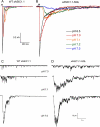Leu85 in the beta1-beta2 linker of ASIC1 slows activation and decreases the apparent proton affinity by stabilizing a closed conformation
- PMID: 20479002
- PMCID: PMC2903392
- DOI: 10.1074/jbc.M110.134114
Leu85 in the beta1-beta2 linker of ASIC1 slows activation and decreases the apparent proton affinity by stabilizing a closed conformation
Abstract
Acid-sensing ion channels (ASICs) are proton-activated channels expressed in neurons of the central and peripheral nervous systems where they modulate neuronal activity in response to external increases in proton concentration. The size of ASIC1 currents evoked by a given local acidification is determined by the number of channels in the plasma membrane and by the apparent proton affinities for activation and steady-state desensitization of the channel. Thus, the magnitude of the pH drop and the value of the baseline pH both are functionally important. Recent characterization of ASIC1s from an increasing number of species has made evident that proton affinities of these channels vary across vertebrates. We found that in species with high baseline plasma pH, e.g. frog, shark, and fish, ASIC1 has high proton affinity compared with the mammalian channel. The beta1-beta2 linker in the extracellular domain, specifically by the substitution M85L, determines the interspecies differences in proton affinities and also the time course of ASIC1 macroscopic currents. The mechanism underlying these observations is a delay in channel opening after application of protons, most likely by stabilizing a closed conformation that decreases the apparent affinity to protons and also slows the rise and decay phases of the current. Together, the results suggest evolutionary adaptation of ASIC1 to match the value of the species-specific plasma pH. At the molecular level, adaptation is achieved by substitutions of nonionizable residues rather than by modification of the channel proton sensor.
Figures





Similar articles
-
Asn415 in the beta11-beta12 linker decreases proton-dependent desensitization of ASIC1.J Biol Chem. 2010 Oct 8;285(41):31285-91. doi: 10.1074/jbc.M110.160382. Epub 2010 Jul 30. J Biol Chem. 2010. PMID: 20675379 Free PMC article.
-
Two residues in the extracellular domain convert a nonfunctional ASIC1 into a proton-activated channel.Am J Physiol Cell Physiol. 2010 Jul;299(1):C66-73. doi: 10.1152/ajpcell.00100.2010. Epub 2010 Apr 28. Am J Physiol Cell Physiol. 2010. PMID: 20427715 Free PMC article.
-
Proton sensitivity of ASIC1 appeared with the rise of fishes by changes of residues in the region that follows TM1 in the ectodomain of the channel.J Physiol. 2005 Nov 1;568(Pt 3):725-35. doi: 10.1113/jphysiol.2005.087734. Epub 2005 Jul 7. J Physiol. 2005. PMID: 16002453 Free PMC article.
-
Insight toward epithelial Na+ channel mechanism revealed by the acid-sensing ion channel 1 structure.IUBMB Life. 2008 Sep;60(9):620-8. doi: 10.1002/iub.89. IUBMB Life. 2008. PMID: 18459164 Review.
-
Acid-Sensing Ion Channels Structural Aspects, Pathophysiological Importance and Experimental Mutational Data Available Across Various Species to Target Human ASIC1.Curr Drug Targets. 2019;20(1):111-121. doi: 10.2174/1389450119666180820103316. Curr Drug Targets. 2019. PMID: 30124148 Review.
Cited by
-
Mechanisms of Action of the Peptide Toxins Targeting Human and Rodent Acid-Sensing Ion Channels and Relevance to Their In Vivo Analgesic Effects.Toxins (Basel). 2022 Oct 17;14(10):709. doi: 10.3390/toxins14100709. Toxins (Basel). 2022. PMID: 36287977 Free PMC article. Review.
-
Asn415 in the beta11-beta12 linker decreases proton-dependent desensitization of ASIC1.J Biol Chem. 2010 Oct 8;285(41):31285-91. doi: 10.1074/jbc.M110.160382. Epub 2010 Jul 30. J Biol Chem. 2010. PMID: 20675379 Free PMC article.
-
Conformational changes in the lower palm domain of ASIC1a contribute to desensitization and RFamide modulation.PLoS One. 2013 Aug 14;8(8):e71733. doi: 10.1371/journal.pone.0071733. eCollection 2013. PLoS One. 2013. PMID: 23977127 Free PMC article.
-
Structure and activity of the acid-sensing ion channels.Am J Physiol Cell Physiol. 2012 Oct 1;303(7):C699-710. doi: 10.1152/ajpcell.00188.2012. Epub 2012 Jul 25. Am J Physiol Cell Physiol. 2012. PMID: 22843794 Free PMC article. Review.
-
X-ray structure of acid-sensing ion channel 1-snake toxin complex reveals open state of a Na(+)-selective channel.Cell. 2014 Feb 13;156(4):717-29. doi: 10.1016/j.cell.2014.01.011. Epub 2014 Feb 6. Cell. 2014. PMID: 24507937 Free PMC article.
References
-
- Waldmann R., Champigny G., Bassilana F., Heurteaux C., Lazdunski M. (1997) Nature 386, 173–717 - PubMed
-
- Wemmie J. A., Chen J., Askwith C. C., Hruska-Hageman A. M., Price M. P., Nolan B. C., Yoder P. G., Lamani E., Hoshi T., Freeman J. H., Jr., Welsh M. J. (2002) Neuron 34, 463–477 - PubMed
-
- Jasti J., Furukawa H., Gonzales E. B., Gouaux E. (2007) Nature 449, 316–323 - PubMed
MeSH terms
Substances
LinkOut - more resources
Full Text Sources

